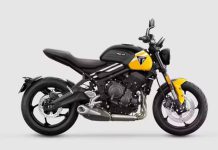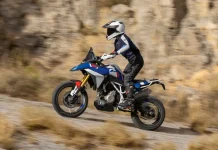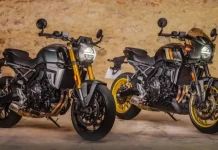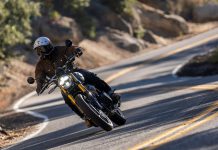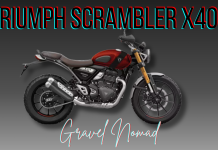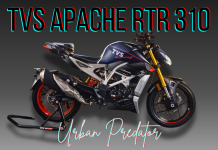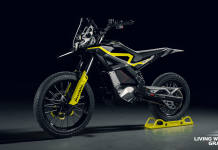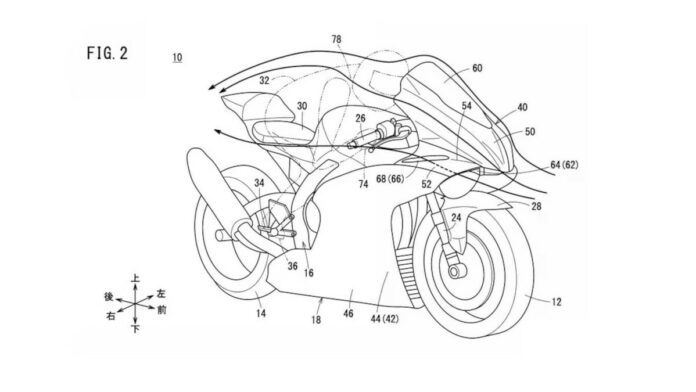The Wings of Change
Winglets provide downforce but increase drag and hurt fuel economy. Honda has patented a new fairing design eliminating protruding wings and using air intakes and flow-through channels to create aerodynamic downforce instead.
This aims to produce downforce while lowering air resistance for improvements to handling, acceleration, top speed, and mileage. However, it remains just a patent concept for now with no production timeline set for use on Honda’s CBR superbikes.
Winglets have become a popular aerodynamic addition to high-performance motorcycles over the last few years. However, they also come with downsides. Manufacturers like Honda are looking into innovative alternative designs that can provide downforce benefits without the drawbacks of winglets.



What Are Motorcycle Winglets?
Motorcycle winglets are small vertical wings or “spoilers” mounted on the sides of the front fairing. They work similarly to airplane wings, generating an aerodynamic force that “pushes” the front of the bike downwards.
This extra downforce improves front wheel traction and handling by keeping the front suspension loaded under hard acceleration and when changing directions.
The Downforce Benefits
On closed circuit racetracks, winglets allow riders to take corners at higher speeds. The improved grip pays major dividends for lap times.
For sports bikes on public roads, most riders don’t push to the limits very often. But the downforce can provide extra confidence when making hard direction changes or accelerating at maximum attack.
This downforce effect is most valuable on superbikes with over 150 or 200 horsepower. Without adequate grip, it’s easy to break traction when applying the power down.
The Downsides of Motorcycle Winglets
While winglets generate noticeable downforce, they come with aerodynamic trade-offs:
- Increased air resistance – The wing protrusions interfere with smooth airflow, increasing drag. This can negatively impact top speed potential.
- More turbulence – Turbulent flows around the sides of the fairing also create drag as air “trips” over itself.
- Fuel efficiency suffers – The added aerodynamic inefficiency takes an extra toll on gas mileage.
So while helpful for maximizing traction in high-performance scenarios, winglets have downsides for real world use. Riders constantly balancing acceleration, speed, and fuel consumption are impacted.
Honda’s Patent for an Alternative Fairing
The aerodynamic compromises have manufacturers exploring alternatives that provide downforce without the usual winglets.
Honda filed a patent for a redesigned fairing that eliminates side wings. Instead, it uses specifically contoured airflow and channels air to produce downforce.
The key goals are:
- Generate increased downforce without winglets
- Reduce air resistance at the same time
- Improve handling, acceleration, top speed, and fuel efficiency in one package
Honda’s Redesigned Fairing Explained
So how does Honda’s new fairing work? The patent design ditches protruding wings and instead utilizes:
- Air intakes positioned around the sides and lower front fairing
- Outlet openings that feed incoming air through the bodywork
- An “inverted wing” front profile shape
This smooths airflow and feeds air through the motorcycle frame itself – generating an aerodynamic downforce effect without wings sticking out into the airstream.
By removing winglets and reducing frontal area, the air resistance also goes down compared to the normal wing and fairing combo.
When Will This Enter Production?
While the patent drawings use the Honda CBR1000RR-R as an example, there’s no confirmation that Fireblade models will adopt this new fairing design anytime soon.
The bike received styling updates for 2024 but still uses conventional winglets. So the wingless fairing remains just a concept on paper so far.
Other Honda models could potentially take advantage of this aerodynamic innovation before the production Fireblade sees any changes.
Pros and Cons
Here are the pros and cons of motorcycle winglets versus Honda’s wingless fairing concept in bullet points:
Motorcycle Winglets
Pros:
- Generate significant downforce
- Improve front grip and handling
- Allow faster cornering speeds
Cons:
- Increase air resistance
- Cause turbulence
- Reduce top speed
- Worse fuel efficiency
Honda’s Wingless Fairing Concept
Pros:
- Increases downforce
- Reduces air resistance
- Improves top speed, acceleration
- Improves fuel efficiency
Cons:
- Downforce levels uncertain
- Concept not production proven
- Timeline to implementation unknown
Winglets provide clear downforce gains but have aerodynamic tradeoffs. Honda’s fairing concept claims improved downforce AND reduced drag, but remains unproven and uncertain for real world production. Racers may still prefer winglets, while road riders likely value efficiency gains over modest handling improvements.
Conclusion
Motorcycle winglets provide increased control and confidence by creating downforce, but not without downsides. The alternative wingless fairing patented by Honda offers a creative method to get the best of both worlds.
Racers chasing every hundredth of a second will likely stick with protruding wings. But for road use by us regular enthusiasts, striking an optimal balance between downforce, drag, and efficiency may win out.
FAQs
What are the key benefits of motorcycle winglets?
Winglets improve front wheel traction and handling by creating aerodynamic downforce. This keeps the front suspension loaded, allowing harder acceleration and quicker turns.
What negatives do winglets have?
The protruding wings increase drag and air resistance. This hampers top speed potential while also decreasing gas mileage.
What does Honda’s new fairing patent aim to achieve?
Honda’s goal is to provide increased downforce through the fairing shape itself without using drag-inducing winglets. Removing the wings further reduces air resistance.
When will Honda’s new fairing enter production?
It’s unknown if or when Honda will introduce this wingless fairing design. The 2024 Fireblade still uses winglets, so the concept remains just a patent for now.
Do you have strong opinions on the tradeoffs of motorcycle winglets? Do you think Honda’s new fairing concept is an improvement? Join the aerodynamic debate and leave your thoughts below!
Weigh in on whether you think winglets are more hype and aesthetics or truly functionally beneficial in the real world. Share what performance and practicality factors are most important to your own riding.
Let your voice be heard on the polarizing topic of motorcycle wings and aerodynamic innovations. Click through to the comment section now – we look forward to seeing travelers, commuters, track riders and all sorts of motorcyclists chime in!

